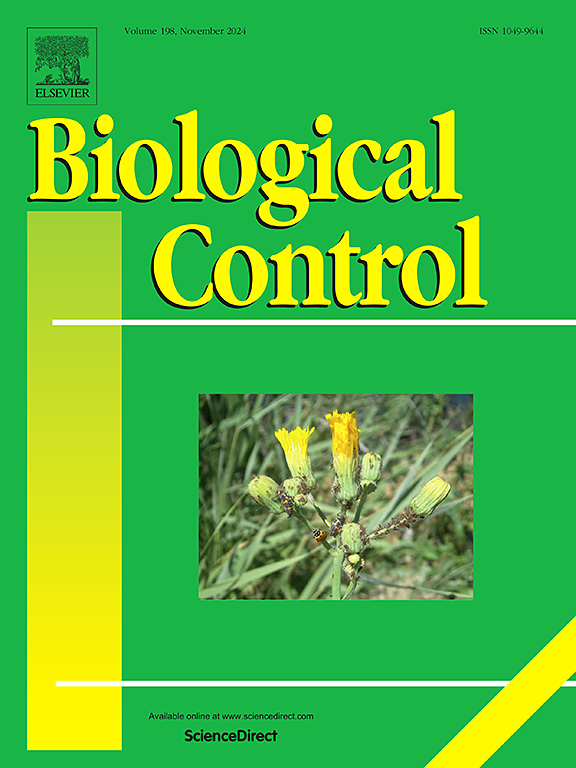Action of Pythium oligandrum on Grapevine Trunk Diseases and its impact on microbial communities
IF 3.4
2区 农林科学
Q2 BIOTECHNOLOGY & APPLIED MICROBIOLOGY
引用次数: 0
Abstract
Grapevine Trunk Diseases (GTDs) have become a major challenge for viticulture. Since the ban of sodium arsenate (the only approved pesticide) in 2001, the need for alternative methods, such as biocontrol, has become increasingly urgent. One promising microorganism is the oomycete Pythium oligandrum, which is known to improve plant health by increasing natural defences and reducing disease incidence by up to 40 %. In order to use this microorganism in vineyards, it need first to be formulated and tested to ensure its safety. An experiment was therefore carried out in a greenhouse under semi-controlled conditions to assess the efficacy of the P. oligandrum biopesticide produced and its impact on microbial communities using a high-throughput sequencing approach. Vines were treated with the biopesticide and were inoculated with two fungi involved in wood diseases: Neofusicoccum parvum (involved in Botryosphaeria dieback) and Phaeomoniella chlamydospora (involved in Esca). During a three-month experiment, samples of the rhizosphere environment were collected to assess possible changes in microbial communities, either as part of GTDs or as a result of the action of P. oligandrum. The results indicated a minimal effect of the P. oligandrum biopesticide on the total microbial community of the vine rhizosphere. However, the treatment appeared to enhance several beneficial taxa that play a role as plant growth promoting rhizobacteria (PGPR) or biocontrol agents (BCA). This improvement, together with the direct effect of P. oligandrum, may explain the reduction in necroses caused by N. parvum and P. chlamydospora following the biopesticide application.

野霉对葡萄主干病害的防治作用及其对微生物群落的影响
葡萄主干病害(GTDs)已成为葡萄栽培面临的主要挑战。自从2001年禁止使用砷酸钠(唯一被批准的农药)以来,对生物防治等替代方法的需求变得越来越迫切。一种很有前途的微生物是卵菌,已知它可以通过增强自然防御和减少高达40%的疾病发病率来改善植物健康。为了在葡萄园中使用这种微生物,首先需要对其进行配方和测试,以确保其安全性。因此,利用高通量测序方法,在半受控条件下的温室中进行了一项试验,以评估所生产的聚甘菊生物农药的功效及其对微生物群落的影响。用生物农药处理葡萄藤,并接种两种与木材病害有关的真菌:新褐球菌parvum(涉及枯死菌)和衣孢费oniella chlamydospora(涉及Esca)。在为期3个月的实验中,收集了根际环境样本,以评估微生物群落可能发生的变化,这些变化可能是gtd的一部分,也可能是由寡甘松的作用引起的。结果表明,寡甘松生物农药对葡萄根际微生物群落的影响很小。然而,该处理似乎增强了一些有益的分类群,这些分类群发挥植物生长促进菌(PGPR)或生物防治剂(BCA)的作用。这种改善,再加上寡聚单胞菌的直接作用,可能解释了在施用生物农药后,由细小单胞菌和衣孢单胞菌引起的死亡减少。
本文章由计算机程序翻译,如有差异,请以英文原文为准。
求助全文
约1分钟内获得全文
求助全文
来源期刊

Biological Control
生物-昆虫学
CiteScore
7.40
自引率
7.10%
发文量
220
审稿时长
63 days
期刊介绍:
Biological control is an environmentally sound and effective means of reducing or mitigating pests and pest effects through the use of natural enemies. The aim of Biological Control is to promote this science and technology through publication of original research articles and reviews of research and theory. The journal devotes a section to reports on biotechnologies dealing with the elucidation and use of genes or gene products for the enhancement of biological control agents.
The journal encompasses biological control of viral, microbial, nematode, insect, mite, weed, and vertebrate pests in agriculture, aquatic, forest, natural resource, stored product, and urban environments. Biological control of arthropod pests of human and domestic animals is also included. Ecological, molecular, and biotechnological approaches to the understanding of biological control are welcome.
 求助内容:
求助内容: 应助结果提醒方式:
应助结果提醒方式:


